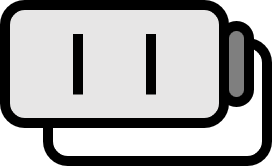Impossibility of Cloning Theorem
| 양자정보이론 | ||||||||||||||||
[ 펼치기 · 접기 ]
| ||||||||||||||||
Theorem1
It is not possible to have a quantum gate that clones the following qubit.
$$ \begin{equation} \begin{aligned} (\mathbb{C}^{2})^{\otimes 2} &\to (\mathbb{C}^{2})^{\otimes 2} \\ \ket{x} \otimes \ket{0} &\mapsto \ket{x} \otimes \ket{x},\quad \forall \ket{x} \in \mathbb{C}^{2} \end{aligned} \end{equation} $$
Here, $(\mathbb{C}^{2})^{\otimes 2}$ is the tensor product of vector spaces, and $\ket{a} \otimes \ket{b}$ is a product vector.
Explanation
One of the fundamental reasons why computation using quantum computers is fundamentally different from classical computers is because it’s not possible to clone quantum information.
There’s an important note about what the theorem says. It does not say that a specific qubit can not be cloned. Rather, it states that there does not exist a gate that clones any arbitrary qubit $\ket{x} \in \mathbb{C}^{2}$. A quantum gate that clones a specific qubit does exist. For instance, under the result of the theorem, if $\alpha$ or $\beta$ is $0$, cloning might be possible. An example would be the quantum $\operatorname{CNOT}$ gate. In other words, in quantum computing, it is only possible to clone exactly two qubits $\ket{0}$ and $\ket{1}$, and cloning a general superposed state is impossible.
$$ \operatorname{CNOT}_{q} (\ket{00}) = \ket{00} \\[0.5em] \operatorname{CNOT}_{q} (\ket{10}) = \ket{11} $$
Proof
Strategy: Prove by contradiction.
Notation: $\ket{ab} = \ket{a} \otimes \ket{b}$
Assume that for any given $\ket{x} = \alpha\ket{0} + \beta\ket{1} \in \mathbb{C}^{2}$ $(0 \ne \alpha, \beta \in \mathbb{C}, \left| \alpha \right|^{2} + \left| \beta \right|^{2} = 1)$, there exists a quantum gate $G$ that satisfies $(1)$. Since unitary operators are linear, the following holds:
$$ \begin{align*} G\left( \ket{x} \otimes \ket{0} \right) &= G\left( (\alpha\ket{0} + \beta\ket{1}) \otimes \ket{0} \right) \\ &= G\left( \alpha\ket{0} \otimes \ket{0} + \beta\ket{1} \otimes \ket{0} \right) \\ &= \alpha G( \ket{00} ) + \beta G( \ket{10} ) \\ &= \alpha \ket{00} + \beta \ket{11} \end{align*} $$
Furthermore, since $G$ satisfies $(1)$, the following holds:
$$ \begin{align*} G\left( \ket{x} \otimes \ket{0} \right) &= G\left( (\alpha\ket{0} + \beta\ket{1}) \otimes \ket{0} \right) \\ &= \left( \alpha\ket{0} + \beta\ket{1} \right) \otimes \left( \alpha\ket{0} + \beta\ket{1} \right) \\ &= \alpha^{2}\ket{00} + \alpha\beta\ket{10} + \alpha\beta\ket{01} + \beta^{2}\ket{11} \\ \end{align*} $$
From these equations, we obtain the following:
$$ \alpha \ket{00} + \beta \ket{11} = \alpha^{2}\ket{00} + \alpha\beta\ket{10} + \alpha\beta\ket{01} + \beta^{2}\ket{11} \\[1em] \implies \alpha^{2} = \alpha,\quad \beta^{2} = \beta,\quad \alpha\beta = 0 $$
This contradicts the assumption $\alpha, \beta \ne 0$, therefore, we can conclude that a quantum gate $G$ that clones any arbitrary qubit does not exist.
■
김영훈·허재성, 양자 정보 이론 (2020), p99 ↩︎
